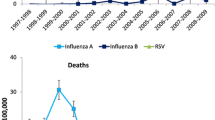Abstract
Introduction
Influenza is associated with illnesses such as pneumonia and other respiratory conditions and in severe cases leads to death. The prevalence of these illnesses and deaths fluctuates with the seasons during the year, even in the absence of influenza. Although many studies have focussed on mortality associated with influenza epidemics, and some have examined hospitalizations in elderly patients, there are very few studies that have examined the effect of influenza epidemics on adults or children. This study seeks to determine the association between general practitioner (GP) consultations for influenza-like illnesses and hospital admissions of adults and children associated with influenza epidemics.
Methods
Structural Time Series Models with stochastic trend and seasonal components were developed for two age groups (children aged 0–15 years, and adults aged 16–50 years). Data from the Swiss Sentinel Surveillance Network on GP consultation rates for influenza-like illnesses, and data from Swiss hospital admissions, were obtained for the period 1987–1996. The explanatory variables (i.e., the percentage of GP consultations for influenza-like illnesses and a 1-week lag of this variable) were modeled against hospital admission rates for pneumonia and influenza and other respiratory conditions. Excess hospitalizations were calculated as the difference between predicted hospital admissions during influenza epidemics and expected hospital admissions in the absence of influenza epidemics.
Results
In these two age groups, there was an annual average of 1452 (range: 1000–1700) hospital admissions directly associated with influenza epidemics. Excess admission rates were substantially higher in children (pneumonia and influenza: 4.77 per 10 000 children per year, and other respiratory conditions: 2.29 per 10 000 children per year) compared with adults (pneumonia and influenza: 0.86 per 10 000 adults per year and other respiratory conditions: 0.68 per 10 000 adults per year). The models explained 56–84% of the variation in hospital admissions. The seasonal patterns were stable over the 10 years modeled and the variances of the trends were small.
Conclusion
The structural time series models is an ideal approach to model influenza-related hospitalizations as the models capture trends, seasonal variation, and the association with exogenous factors.










Similar content being viewed by others
References
Fleming DM. The contribution of influenza to combined acute respiratory infections, hospital admissions, and deaths in winter. Commun Dis Public Health 2000; 3 (1): 32–8.
Nichol KL, Wuorenma J, Von Sternberg T. Benefits of influenza vaccination for low-, intermediate-, and high-risk senior citizens. Arch Intern Med 1998; 80 (16): 1769–76.
Simonsen L, Fukuda K, Schonberger LB, et al. The impact of influenza epidemics on hospitalizations. J Infect Dis 2000; 181 (3): 831–7.
Chiu SS, Lau YL, Chan KH, et al. Influenza-related hospitalizations among children in Hong Kong. N Engl J Med 2002; 347 (26): 2097–103.
Izurieta HS, Thompson WW, Kramarz P, et al. Influenza and the rates of hospitalization for respiratory disease among infants and young children. N Engl J Med 2000; 342 (4): 232–9.
Neuzil KM, Meilen BG, Wright PF, et al. The effect of influenza on hospitalizations, outpatient visits, and courses of antibiotics in children. N Engl J Med 2000; 342 (4): 225–31.
Nguyen-Van-Tarn JS, Brockway CR, Pearson JCG, et al. Excess hospital admissions for pneumonia and influenza in persons ≥65 years associated with influenza epidemics in three English health districts: 1987–95. Epidemiol Infect 2001; 126: 71–9.
International Classification of Disease, ninth revision, Clinical Modification. Geneva: World Health Organization, 1980.
Harvey AC. Forecasting, structural time series models and the Kaiman filter. Cambridge: Press Syndicate of the University of Cambridge, 1989.
Harvey AC, Durbin J. The effects of seat belt legislation on British road casualties: a case study in structural time series modelling. J R Stat Soc 1986; 149 (3): 187–227.
Cuthbertson K, Hall SG, Taylor MP. Applied econometric techniques. Hertfordshire: Philip Allan, 1995.
Box GEP, Jenkins GM. Time series analysis, forecasting and control. San Francisco (CA): Holden-Day, 1970.
Kaiman RE. A new approach to linear filtering and prediction problems. J Basic Engineering 1960; 82: 35–45.
Kaiman RE, Bucy RS. New results in linear filtering and prediction theory. J Basic Engineering 1961; 83: 95–108.
Koopman SJ, Harvey AC, Doornik JA, Shephard N. STAMP 5.0. London: Chapman & Hall, 1995.
Hendry DF, Pagan AR, Sargan JD. Dynamic specification. In: Gilriches Z, Intriligator MD, editors. Handbook of econometrics. New York: North-Holland, 1984: 1023–100.
Ljung G, Box G. On the measure of lack of fit in time series models. Biometrika 1978; 66 (297): 67–72.
Bowman KO, Shenton LR. Omnibus test contours for departures from normality based on √bl and b2. Biometrika 1975; 62: 243–50.
Fleming DM, Cross KW. Respiratory syncytial virus or influenza? Lancet 1993; 342: 1507–10.
Fedson DS. Evaluating the impact of influenza vaccination: a North American perspective. Pharmacoeconomics 1996; 9 Suppl. 3: 54–61.
Acknowledgements
This study was funded through a subcontract with MAPI Values, Bollington UK, by the Swiss Department of Health. I am grateful to Professor David Fedson (Aventis-Pasteur, Lyon, France), Professor Margaret Burgess (Director, NCIRS, University of Sydney, Sydney, Australia) and Dr Peter West (Director, YHEC, University of York, York, UK) for their constructive comments on a previous draft, Daniela Mueller for her assistance in obtaining Swiss data and James Piercy (MAPI-Values) for his assistance with obtaining data and comments. I am also grateful to comments received from the audiences attending the seminar presentations at the Health Economics Research Centre, University of Oxford, and the Centre for Health Economics, University of York, as well as those received from the anonymous referees.
Author information
Authors and Affiliations
Corresponding author
Rights and permissions
About this article
Cite this article
Scuffham, P.A. Estimating Influenza-Related Hospital Admissions in Children and Adults. Dis-Manage-Health-Outcomes 11, 259–269 (2003). https://doi.org/10.2165/00115677-200311040-00006
Published:
Issue Date:
DOI: https://doi.org/10.2165/00115677-200311040-00006




